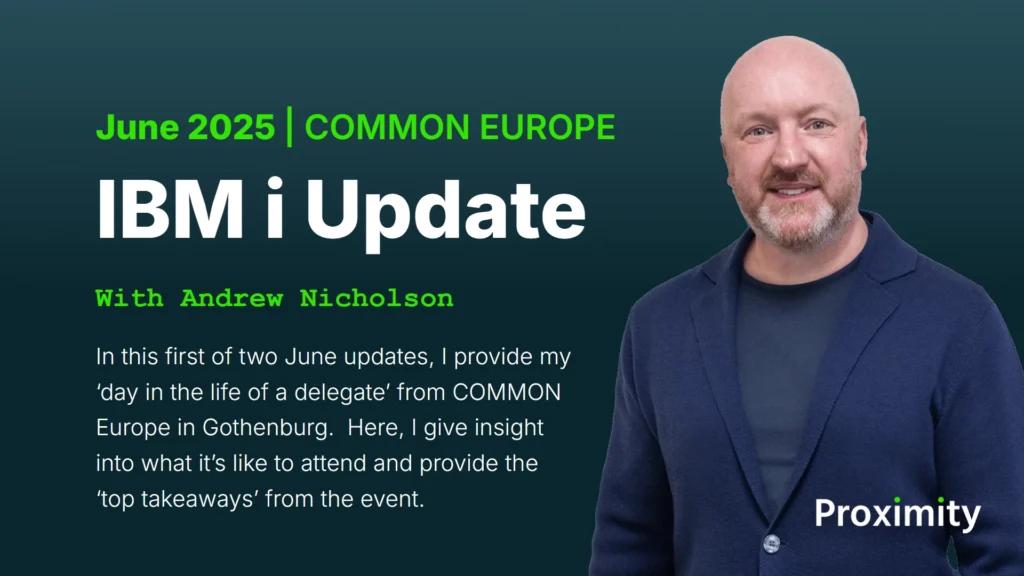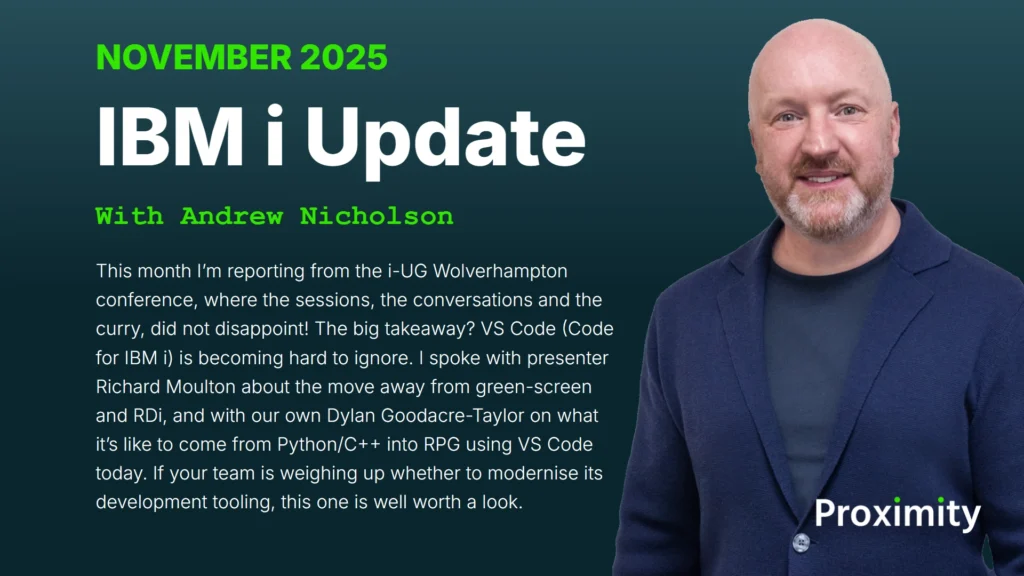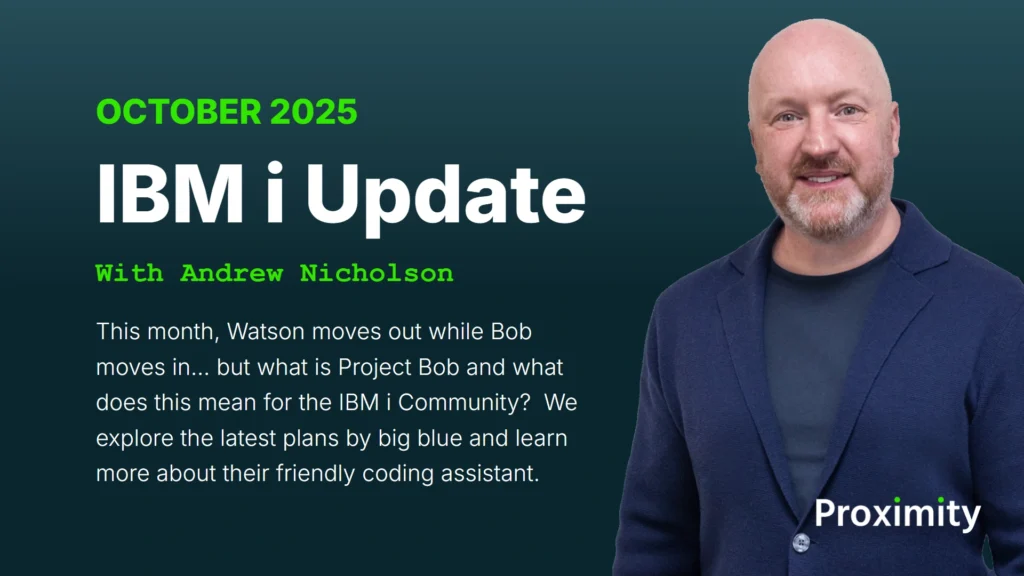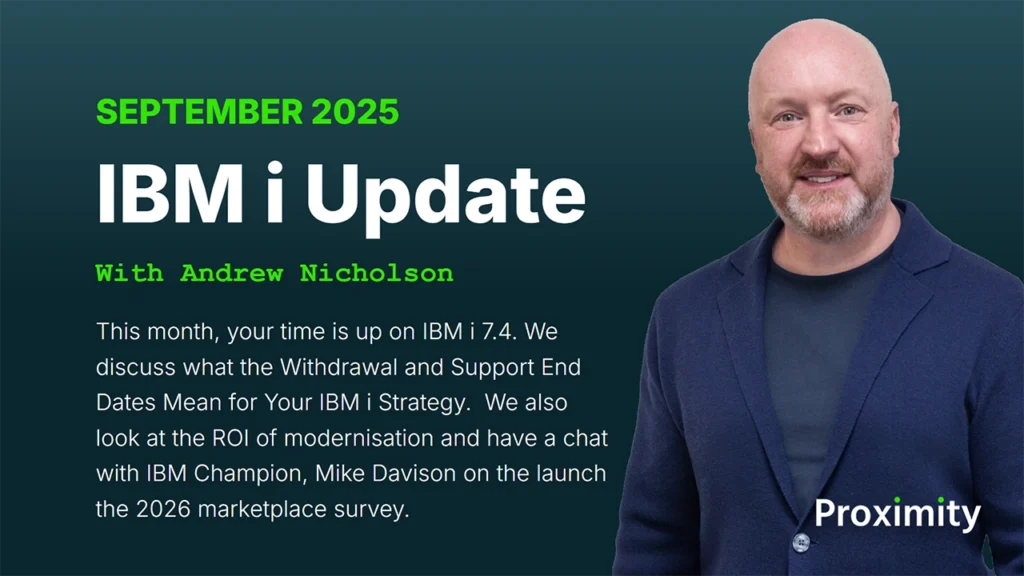Welcome to your IBM i update for June 2025, this is the first of a two part special reporting from the June IBM i events in Sweden and the UK!
This part covers COMMON Europe in Gothenburg. Here, I give insight into what it’s like to attend and provide ‘top takeaways’ from the pick of the presentations.
Watch the video below, or read the full article underneath.
Common Europe – Gothenburg Overview – June 2025
Welcome to Gothenburg, where, here at the Gothia Towers hotel and exhibition center, COMMON Europe was taking place. This four day event had everything needed for the IBM i professional.
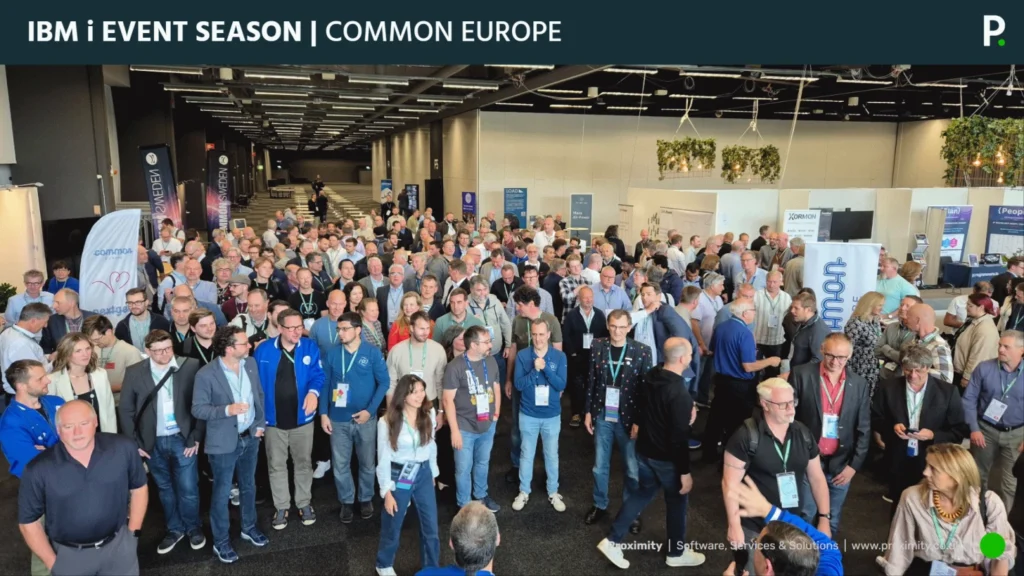
From hands-on workshops to technical presentation, Business Strategy to Personal Developments, there were sessions for you.
So, if you were there – I’ll provide a recap of what I thought were some of the most interesting events. If you weren’t there then hopefully, this will provide a flavour on what COMMON is all about plus provide some insight into some key sessions I attended.
Let’s start by saying the event is the biggest of its type in Europe. Over 450 IBM iers flitted around the the caverness halls within the Expo centre.
Here, exhibitors from all over the world were on hand to provide real-world solutions for business running on IBM Power.
Within easy reach of the expo centre were the session rooms including the main hall in which the keynote speeches were held.
And that’s perhaps a good place to start, my first of my key picks at this years expo.
How IBM have made AI simple, and fast
This Keynote by AI on IBM Power Technical Lead, Sebastian Lehrig, discussed how IBM have made AI simple and fast.
Now, to do so, Sebastian explained that you first need to tackle the common barriers.
The top barrier, garnering over 50% of the his concern was with data privacy.
Sebastian explained that trust and transparency were of great concern – ensuring you protect personal or identifiable information and meeting your regulatory obligations impact over 90% of all AI projects.
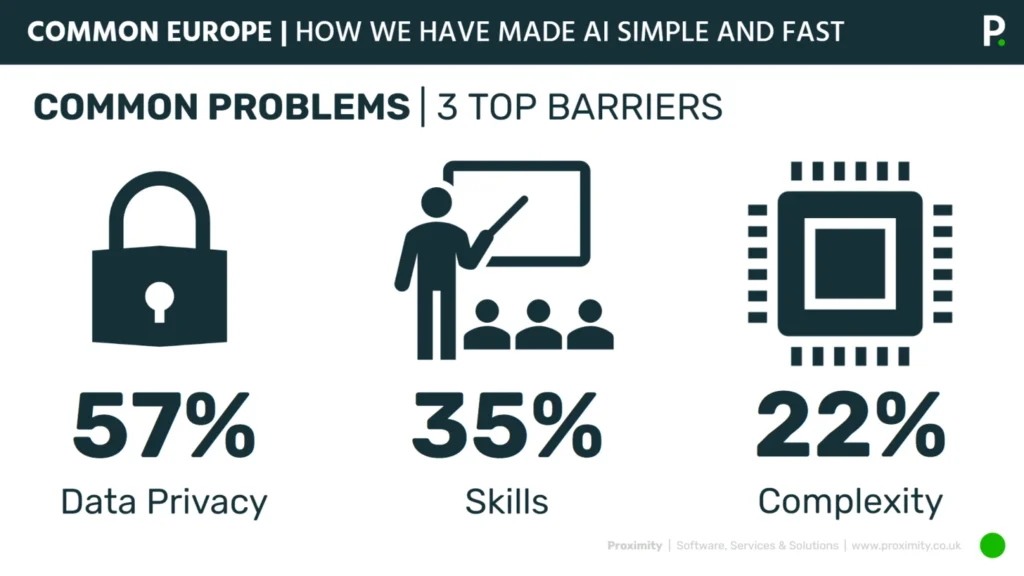
Skills too prohibit 35% of AI initiatives with skill shortages relating to data security, literacy and coding skills sited. Then finally, 22% of organisations say AI projects are too complex or difficile to implement or scale.
So, the question that Sebastian posed was, how can we overcome these barriers and provide a simple and easy path to AI success?
Well, thankfully, the good people at big blue have thought of that and can support your AI requirements through their ecosystem and technology stack built on Power.
And Sebastian went on to provide some real work examples on how this technology can be and indeed, has been utilised.
One particular example was with Hans Geis, a global logistics provider running on IBM i.
Through the introduction of AI, they’re sped up the sales order processing process by over 5x.
Essentially, AI handles the incoming request for quotation emails, it analyses the content, creates the proposal and provides a ‘review and submit’ process for the employee to edit (if needed) sign off and send.
This AI addition enhanced employee productivity by lowering the processing time by 80%. Simple, elegant and effective. And remember, this was a business running on IBM i.
Ok ok, but what do we need to run this? The enterprise may be running on IBM i, but did they need banks and banks of GPUs and… how expensive is all of this?

Well, running your AI on a 3 core Power 10 provides a better total cost of ownership than the equivalent x86 model.
And no GPUs needed, IBM have their own solution called Spyre.
Essentially, you have a bank of 8 of these small form PCIe card and combined, they provide 1tb of LPDDR5 memory providing 1.6tb per second of aggregate memory bandwidth – this is all scalable and supported by a team of engineers with AI know-how.
Now, for the IBM i enterprise, you’d need a Power 10 with a Linux partition to get up and running, but the technology is there, the infrastructure is there and the support it there too – compelling stuff.
Current technology drivers and how the IBM i strategy and roadmap are adapting
This leads nicely into my next feature pick in which Steve Will, IBM i CTO & Chief Architect, discussed current technology drivers in the industry, and how the IBM i strategy and roadmap are adapting.
Now, during his presentation he introduced the new features of 7.6… and should you be interested in learning more, please do see the April 2025 edition of the IBM i Update.
But much of Steve’s presentation focused on getting value from running applications on the platform and how they make it easier for businesses to justify continuing their journey on IBM i.
Steve explained that the plan is to continue to support releases for several years or up to a decade should the client pay a little extra money.
Steve went on to explain what IBM i needs to look like in the future with the focus being on a platform that integrates data with cloud.
One of the areas in which Steve is looking at is to provide a place in which you can run open source Linux models and tools and allow them to integrate nicely with your ‘i’ applications.
Now, this isn’t there yet but it’s a direction of travel… as were the AI elements.
Taking aside the generative approach, Steve discuss realising the integrated promise of IBM i and explained that by harnessing the potential of Agentic AI and facilitating its abilities in development, management and data access would be a game changer.
Steve explained that he asked an AI what agentic AI was and how it relates to Model Contect Protocol (or MCPs as they’re known) [AGENTIC AI].
The answer was that it’s an application that can act autonomously to understand, plan and execute a specific task, AI agents use LLMs to reason and can interface will tools, other models, and other IT systems to fulfill user goals.
What IBM intend to do is to provide this server side MCP support so no matter what chat interface you’re working with, the IBM i will be able to interface with it and facilitate the functions needed to make decisions and perform actions.
IBM watsonx code assistant for i
During his presentation, Steve mentioned the newly named watsonx code assistant for i, and during the conference, and for the first time, you could get to see it in action.
Therefore, I joined Adam Shedivy, a software developer at IBM to preview the tool.
Adam showed the assistant in action – explaining and summarising code.
However, the end goal will be to provide similar results to that of the code assistant for Z.
There, IBM found that the assistant could improve productivity by up to 47% in the understand and refactor phase and had a 60% reduction in effort during the coding phase.
Now aside from the impressive demonstration, what was also made clear is that the future development environment may not be RDi, or even Merlin – the future may well be VS code.
We look forward to testing this ourselves and will report back once we’ve gone through the public preview.
A day in the life of using AI on the IBM i
As a change of pace, I joined Steve Wolk for a walkthrough of a typical ‘day in his life’… using AI.
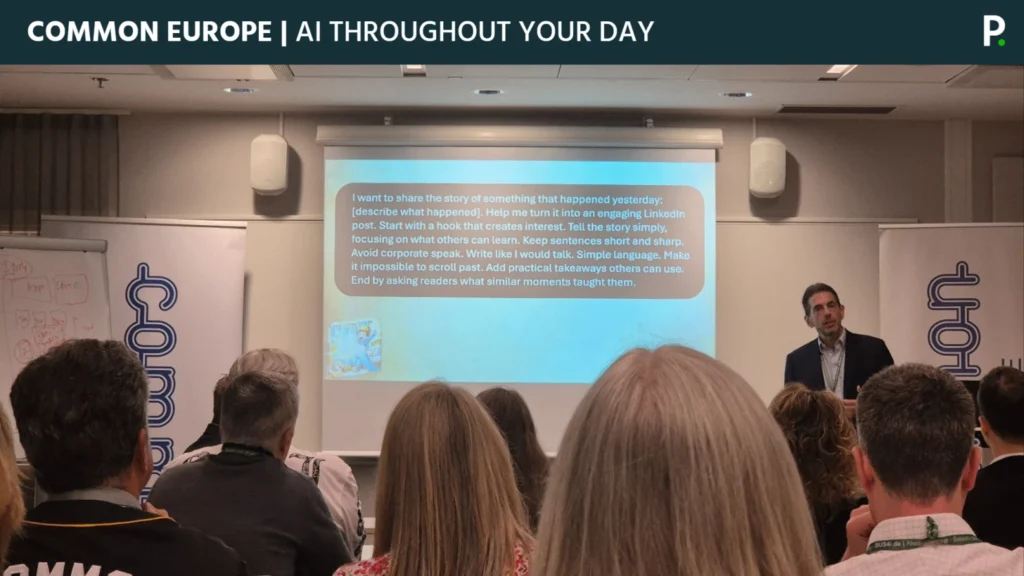
Now, if you’ve never had the privilege to hear Steve speak, please do – he has a wonderful way of simply explaining complex things in an entertaining and engaging manner.
In this session, Steve skipped the ‘tech’ and dove straight into real-world AI applications that help him boost productivity and streamline daily tasks.
Here I learned the right clients to use to automate email, analyse data but the real quick productivity improvement was to use ‘talk’ feature on the ChatGPT app to tailor and read me my news and emails plus dictate and compile notes and ideas during the daily commute – you can even discuss challenges you’re facing and get ideas on solutions… all while stuck in traffic – gold for someone like me.
Common Europe refreshments, giveaways & banquet dinner
After the sessions, it was time to unwind within the expo hall with a glass of wine or beer or two and have a chat with fellow delegates and vendors.
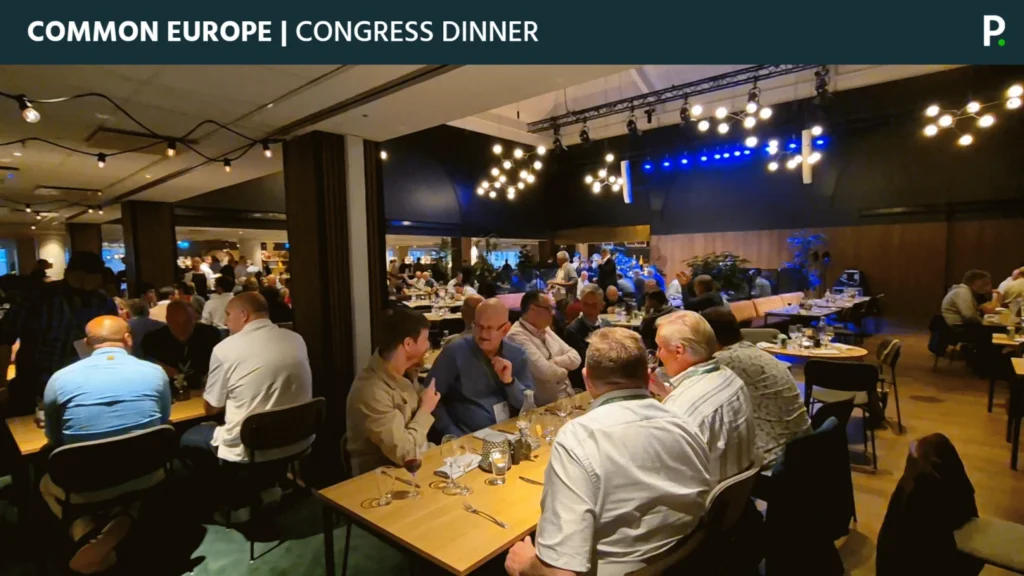
Speaking of vendors, the prize for the booth with the best give-aways went to Remain Software with their assortment of holland related goodies, including models and even a stroopwafle – a favourite treat of mine.
Later still we were off to the banqueting hall for the congress dinner – there we were entertained by a pianist while an assortment of delights was available as a buffet in all corners of the room.
A wonderful meal and evening wa enjoyed by all and my thanks to the organisers for putting on such a good event.
Open Q&A – Recommendations for starting a career in IBM i
On final day of the congress, a selection of the top experts joined the stage for an open Q&A. One of the questions involved was, “what would your recommendations be for starting your career in IBM i?”
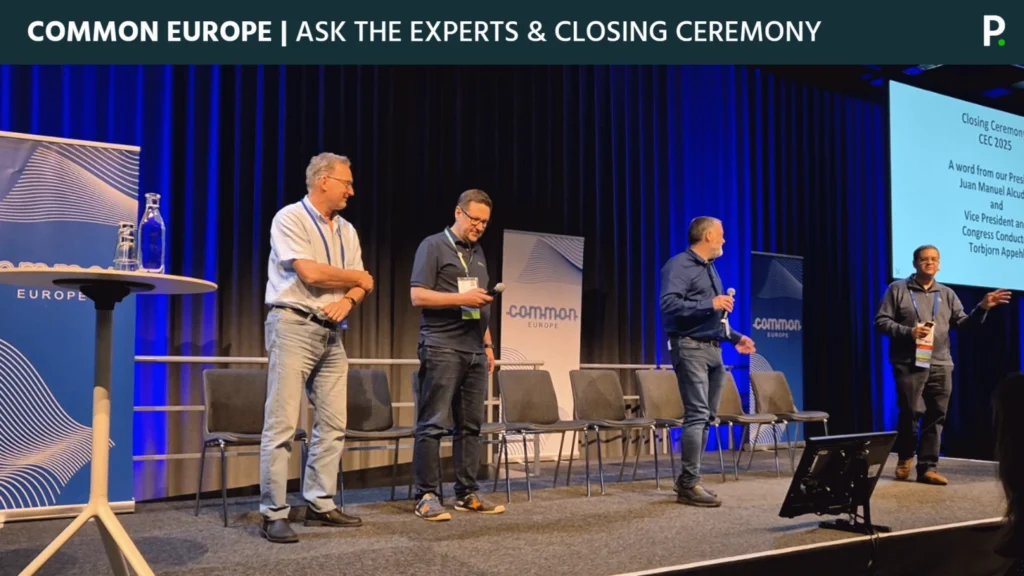
Charles took this and explained that “AI and security would be top, as would application development.”
However, he also went on to say that he wouldn’t want to be immersed in one language and one platform – that’s not our world anymore.
He recommended looking at multiple stacks, even if you’re not proficient, the knowledge in these areas and their capabilities would be a welcome skill.
The event closed with Steve Cast providing a barnstormer of a speech explaining that this year’s event was the largest of its type with over 460 attendees from 20 countries enjoying 73 speakers over 170 sessions – it really was quite the event!
And that’s it for this first of my two part IBM i Update for June.
I’ll be back soon with the second part of which covers the i-Power event in Northampton UK.
We’ll see you next time.
All the best, Andy
Catch our previous May 2025 IBM i Update here. We’ve also got a summary of all the IBM i Updates published in 2024 here.
Follow this link to access all the IBM i Update’s in one place.
Alternatively, if you’d like to receive the latest IBM i Update hot off the press to your inbox, subscribe to the newsletter version on LinkedIn.

